HUNGER STRIKE PROTESTS DECADES OF SOLITARY CONFINEMENT
JUDGE RULES PRISONERS CAN BE FORCE-FED AS AT GUANTANAMO
Posted on August 19, 2013 by prisonerhungerstrikesolidarity
http://prisonerhungerstrikesolidarity.wordpress.com/
Supporters of prisoners who are on the 43rd day of hunger strike are expressing outrage at an order signed today by a federal judge allowing strikers to be force fed, disregarding international human rights principles.
“CDCR justifies asking for the order to force feed by claiming that the widespread hunger strike is ‘orchestrated’ by gangs, that the massive participation and support for the demands is coerced and that prisoners have signed ‘do not resuscitate’ directives under duress,” according to Claude Marks of the Prisoner Hunger Strike Solidarity Coalition. “This order violates all international laws and standards and gives the medical director of each prison authority to violate human rights laws instead of reasonably negotiating with prisoners.”
Thousands of prisoners have united to challenge the torture of prolonged isolation, demanding an accountable process to challenge the gang validations that have kept them in security housing for decades.
Continues Marks, “”This approach, much like Guantanamo, sets the US apart from all related international human rights standards.”
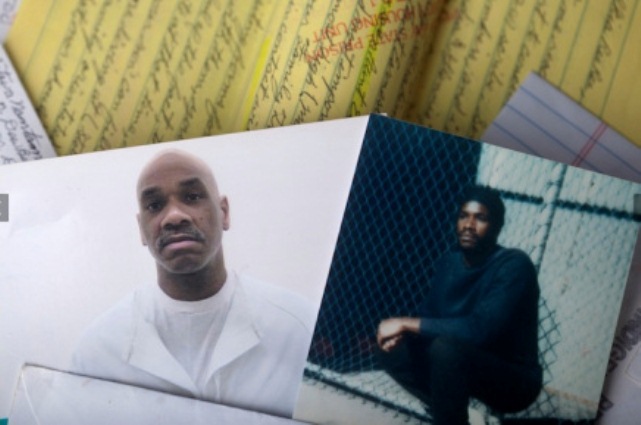
Sitawa Nantambu Jamaa, s/n Ronnie Dewberry, is shown in pictures taken in 2012 and 1988. After over 20 years of refusing to allow prisoners in the Pelican Bay SHU to be photographed, administrators relented in the past few months, taking pictures that prisoners can share with their loved ones. Pelican Bay is so remote that many prisoners’ families are unable to visit often, so they treasure a recent photo. – Photo: Adithya Sambamurthy, CIR
CDCR’s $9.2 billion corruption machine vs. Prison Human Rights Movement
by Sitawa Nantambu Jamaa, PBSP-SHU Short Corridor Collective
Aug. 14, 2013 – I would like to reiterate that the Agreement to End All Hostilities, issued Aug. 12, 2012, is significant for all prisoners because CDCR (California Department of Corrections and Rehabilitation) has encouraged prisoners in their 33 prisons to not only engage in self-destructive behavior but has also helped heighten racial hostilities – the catalyst for internal warfare, racial warfare and gang warfare – all of which has been magnified inside the prisons and throughout our communities.
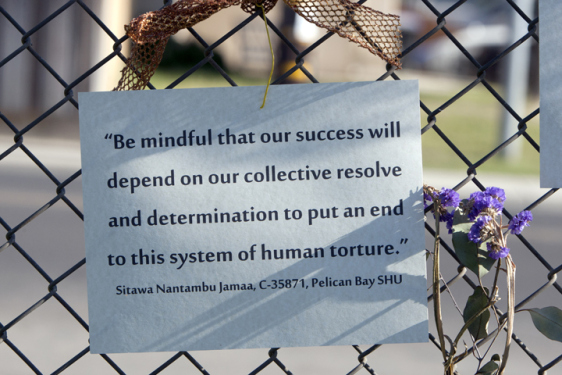
Hunger striker supporters displayed photos and quotations from several of the movement leaders, including Sitawa, at the July 13 rally outside Corcoran State Prison. – Photo: Malaika Kambon
We decided to address these contradictions head on by engaging in a dialogue that was meaningful, sincere and honest with each respective entity. We realized that our responsibility was to end actions that were contrary to the growth and development of each and every prisoner.
We have been attempting to end hostilities for the last 13 years, but the CDCR was not a willing participant in the process. In 2000, we were allowed to get together and work on ending racial and gang riots and to end internal violence.
The CDCR, after realizing that we were successful in our attempts, became very irritable and obstructionist toward our work and proceeded to deliberately sabotage it. During a racial riot in 2000, a young prisoner was murdered by a prison guard. Young prisoners were being murdered in these racial riots; their actions were used by prison guards to justify their being shot for being armed with a weapon – i.e., a makeshift prison knife.
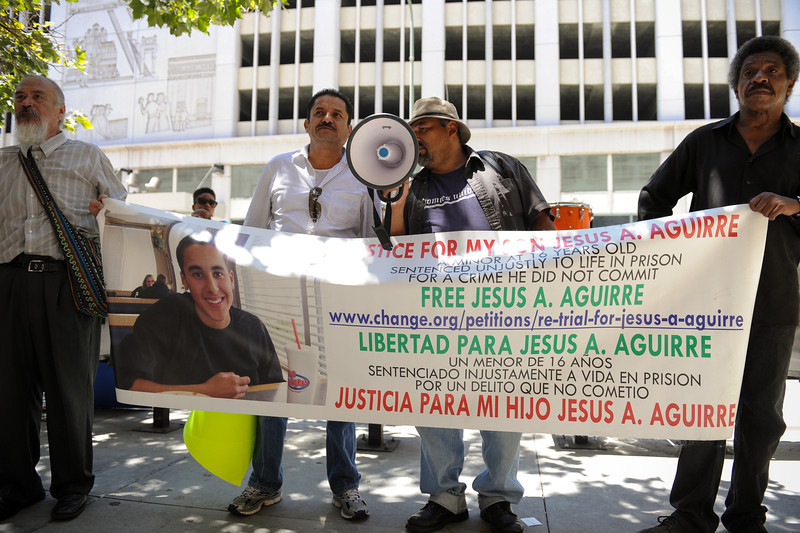
Protests outside the Ronald Reagan State Building in downtown L.A. Monday, July 8, 2013, against solitary confinement in California prisons. (Michael Owen Baker/L.A. Daily News)
Countless prisoners have been murdered in cold blood under the CDCR’s “no warning shot policy.” The prison guards justify killing the prisoners because, they say, they thought they saw a weapon or witnessed one prisoner advancing on another. We consider this to be cold blooded murder. We called for an end to hostilities to eliminate giving prison guards an excuse to kill prisoners.
We realize that the justification for locking men and women away in solitary confinement on prison gang validations indefinitely while also subjecting us to a military debriefing process as the only way to program out constitute attacks to our physical and psychological well-being. Prisoners can no longer withstand such torture.
This process has led to many debriefings and mentally ill prisoners throughout CDCR: in PBSP-SHU, Corcoran SHU, Tehachapi SHU, Folsom SHU and San Quentin Adjustment Center (Death Row). As people who have suffered under such a brutal, diabolical system, we realize that it is our responsibility to help change the course of violent prison systems that have made their way to our communities.
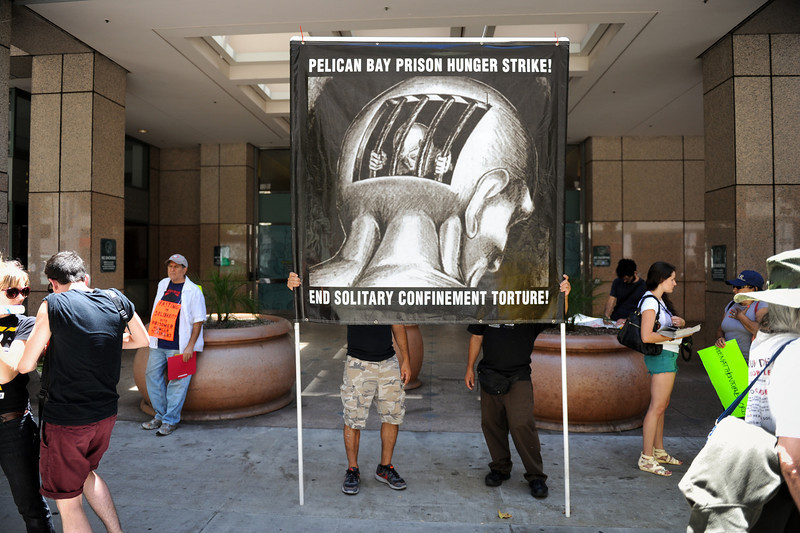
A pair holds a solitary confinement protest sign outside the Ronald Reagan State Building in downtown L.A. Monday, July 8, 2013, during a protest against solitary confinement in California prisons. (Michael Owen Baker/L.A. Daily News)
Orchestrated activities are carried out by debriefers and collaborators whose sole role is to maintain hostilities and deepen infiltration and entrapments within our communities in association with the law enforcement in the streets.
We had been talking about playing a greater leadership role for the last 13 years throughout the PBSP-SHU, but we were unable to agree collectively due to our isolation. So when powerful entities within the California prison system – Institutional Gang Investigators (IGI), Investigations Services Unit (ISU) and Office of Correctional Safety (OCS) – isolated us together in the short corridor, a super-max SHU, we were able to re-open our dialogue and agreed to ending the blatant attacks that our families, friends and associates were being subjected to – the same attacks that we were being subjected to in solitary confinement.
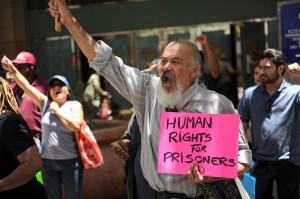
Guillermo Cuauhtemoc protests outside the Ronald Reagan State Building in downtown L.A. Monday, July 8, 2013, against solitary confinement in California prisons. (Michael Owen Baker/L.A. Daily News)
We called for an end to hostilities to eliminate giving prison guards an excuse to kill prisoners.
We realize nothing productive can be done to change the current state of our situation, our prison environment, unless we end the hostilities between prisoners and end all racial and gang violence within the CDCR.
We feel that prisoners are the victims of a systematic process that manipulates them through racial and gang violence in order to prevent greater unity.
In solidarity, struggle, love and respect,
Sitawa
Sitawa Nantambu Jamaa is one of four members of the PBSP-SHU Short Corridor Collective who sit at the negotiating table whenever Gov. Jerry Brown authorizes the CDCR to negotiate the hunger strikers’ demands. Send our brother some love and light: Sitawa Nantambu Jamaa (R. Dewberry), C-35671, Pelican Bay State Prison SHU, D1-117L, P.O. Box 7500, Crescent City CA 95532.
STATEMENT FROM THE PRISON MEDIATION TEAM
Posted on August 19, 2013 by prisonerhungerstrikesolidarity
Day 43 – Time to Re-Frame the Debate
It is difficult to be a Mediator in a situation where no “negotiations with terrorists” are allowed to take place. But let’s start with that word “terrorist,” a grossly overused label in our post 9/11 era. It is meant to demonize. It is meant to conjure up fear and loathing. It is meant to justify any level of violence to counter the fear. Yet what we are dealing with in this non-violent struggle to improve prison conditions is a group of well-disciplined prisoners who have been working across their ethnic differences to adopt non-violent, historically grounded methods to focus attention on their grievances. And in between hunger strikes they reinforced their commitment to non-violence by issuing a Call to End Hostilities between so-called gang groups. So “terrorism” has no place in the discussion.
Taking a non-negotiation stance is reminiscent of hostage taking strategy. “We don’t negotiate with people who kidnap and hold hostages.” But when the Mediation Team questioned that terminology with the CDCR during the first hunger strike in 2011 we were told “but we are being held hostage by this strike.” Really? The prisoners themselves are bearing the suffering of their action, a hallmark in non-violent tactics. They have no power, except the moral power that the opponent feels as he/she/they confront the suffering of the strikers. All the power rests with the Department to either make the changes that are suggested, stonewall the demonstrators, and/or punish the demonstrators. So far the last two responses are the only ones they have chosen.
The Department claims that the leaders of the strike are forcing prisoners to refrain from eating. Yet every instruction they have issued, in our hearing, says the opposite. People should make their own decisions about whether to go on hunger strike and how long to remain on strike. People with pre-existing medical conditions should think carefully before going on hunger strike. People should accept re-feeding if their bodies are telling them they have had enough. The strike started with 30,000 prisoners and is down to a few hundred. If people were being forced to stay on, they don’t seem to be complying. Could there be some people in the system who feel peer pressure? Certainly. Could there be rogue actors, among the correctional officers or the prisoners, causing problems for people who start eating? Probably. But our Coalition has contact with prisoners and their visitors in institutions throughout the state and believes that a minimum of coercion, if any, is in play here.
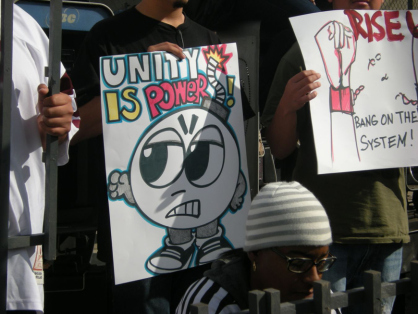
A rally organized by LA’s Youth Justice Coalition ushered in a new era for California prisoners – the End to Hostilities – on the day it took effect, Oct. 10, 2012. A prisoner at Corcoran said recently, “The End to Hostilities has opened up a whole new world to us.” Spreading the spirit of solidarity to the streets is critical now that the California prison system has expanded eligibility for indefinite placement in solitary confinement from prison gangs only to street gangs. – Photo: Virginia Gutierrez
What do the prisoners themselves say about what they are doing? Sitawa Nantambu Jamaa, one of the four representatives at Pelican Bay said this week, “As people who have suffered under such a brutal, diabolical system, we realize that it is our responsibility to help change the course of violent prison systems that have made their way to our communities… We called for an end to hostilities to eliminate giving prison guards an excuse to kill prisoners. We realize nothing productive can be done to change the current state of our situation, our prison environment, unless we end the hostilities between prisoners and end all racial and gang violence within the CDCR. We feel that prisoners are the victims of a systematic process that manipulates them through racial and gang violence in order to prevent greater unity.”
The only way the strike can end without any more participants dying is if the Department begins to see the prisoners as humans, not just as people who have committed crimes, usually decades earlier. Without this breakthrough there will be deaths.
But an equally serious problem is that our own humanity is compromised when we demonize “the other,” and dismiss their humanity. Experienced practitioners of non-violence—such as Gandhi or Cesar Chavez—counseled that hunger strikes should only be used to raise issues within one’s community, where the moral imperative being lifted up can be embraced and real change can take place. When the opponent doesn’t feel that human affinity, all may be lost. It is sobering to remember that Cesar Chavez fasted to the point of permanently harming his own health, and died prematurely. We appeal to Secretary Beard and Governor Brown to demonstrate their humanity by making the reasonable changes that are being requested before it is too late. History will hold them accountable for these lives.
On behalf of the Mediation Team,
Laura Magnani, American Friends Service Committee (415) 565-0201 Ext. 11
Hunger Strike Mediation Team
Dr. Ronald Ahnen, California Prison Focus and St. Mary’s College of California
Barbara Becnel, Occupy4Prisoners.org
Dolores Canales, California Families to Abolish Solitary Confinement
Irene Huerta, California Families to Abolish Solitary Confinement
Laura Magnani, American Friends Service Committee
Marilyn McMahon, California Prison Focus
Carol Strickman, Legal Services for Prisoners With Children
Azadeh Zohrabi, Legal Services for Prisoners With Children
Call Governor Jerry Brown
Phone: (916) 445-2841, (510) 289-0336, (510) 628-0202
Fax: (916) 558-3160
Suggested script: I’m calling in support of the prisoners on hunger strike. The governor has the power to stop the torture of solitary confinement. I urge the governor to compel the CDCR to enter into negotiations to end the strike. RIGHT NOW is their chance to enter into clear, honest negotiations with the strikers to end the torture.
PLEDGE OF RESISTANCE WEEKLY ALERT!
Take the Pledge of Resistance to Stop Torture in the SHU
Sign the petition to the Governor
FEDERAL JUDGE GRANTS CALIFORNIA PERMISSION TO FORCE-FEED INMATES ON HUNGER STRIKE
August 20, 2013 01:49
SACRAMENTO, CA — A US federal judge ruled that state and federal prison officials in California will be allowed to start force-feeding inmates participating in a nearly two-month-long hunger strike, if the prisoners appear to be approaching their death.
The California Department of Corrections, in conjunction with federal officials, requested the permission on Friday, saying they were concerned about the health of approximately 70 inmates who have refused meals since July 8. Roughly 130 inmates across California remain on hunger-strike, protesting the policy of isolating gang leaders and violent offenders in solitary confinement indefinitely.
Prison officials already have the power to compel inmates to eat, although that process requires a court order for each individual. Monday’s court order, signed by US District Judge Thelton Henderson, allows the Department of Corrections to skip the case-by-case scenario and instead force-feed all inmates, including those who recently signed legally-binding “do not resuscitate” (DNR) requests.
The demonstration initially included 30,000 of the 133,000 prisoners in California. Under current prison policy, inmates are allowed to starve to death if they refuse their food and have signed DNR requests, AP reported.
The so-called “refeeding” process involves feeding prisoners intravenous fluids through their noses and into their stomachs. Judge Henderson instructed officials to act only if the chief medical executive at a facility determines a hunger striker is at risk of “near-term death or great bodily injury.”
The exact number of inmates participating in the protests has decreased. While some have stopped protesting on their own, others were forced to quit after being hospitalized for symptoms including dehydration, cramping, vomiting, diarrhea, dizziness, and other maladies.
The hunger-strike, a rare moment of cooperation among notorious prison gang leaders, began as a measure against long-held detention policies, overcrowding, and poor conditions.
Despite repeated condemnations from an assortment of judges, the United Nations, and various human rights groups, solitary confinement has become an increasingly viable option for prisons that need to segregate individual prisoners. The American Civil Liberties Union asserted in a recent report that New York prison inmates may be sentenced to solitary confinement for “infractions as minor as having too many postage stamps or a messy cell.”
The Scientific American conducted a 1957 study on volunteers who were subjected to isolation simulations. Upon completion, most participants performed poorly on simple tests examining arithmetic, word association, and pattern recognition capabilities, according to independent news organization Mother Jones. Others experienced sudden emotional responses and vivid hallucinations.
“Nearly all of them reported that the most striking thing about the experience was that they were unable to think clearly about anything for any length of time and that their thought processes seemed to be affected in other ways,” the results stated. “They were sick people.”
Marie Levin, who is part of the coalition Prisoner Hunger Strike told Boston public radio show “Here and Now” that isolation cells are inhumane. Levin’s brother has been locked up in a US prison since 1981.
“It’s a concrete, windowless cell that’s 8 by 12 [feet],” she said. “It only contains a sink, a toilet and a little stub that they sit on. There are no windows, so they’re circulating air that comes in, but no fresh air. They can’t look out to see sunlight.”
Inmates’ attorneys and prison officials have previously argued over whether California prisoners should be allowed to voluntarily begin a liquid-only diet.
“Patients have a right to refuse medical treatment. They also have a right to refuse food,” Joyce Hayhoe, a spokeswoman for the federal receiver’s office, told AP.
“If an inmate gets to the point where he can’t tell us what his wishes are, for instance if he’s found unresponsive in his cell, and we don’t have a DNR, we’re going to get nourishment into him. That’s what doctors do. They’re going to follow their medical ethics. We’d take any and all measures to sustain their life.”
Both prison officials and attorneys representing the remaining demonstrators claim they are willing to compromise. Lawmakers say the effort is fueled by gang leaders seeking more power behind bars, while inmates’ attorneys have repeatedly told the media they are seeking a compromise to benefit both parties.
“Being rational seems to have left this debate,” Jeanne Woodford, former head of the California prison system under Governor Arnold Schwarzenegger, told the Los Angeles Times. “It’s people who have dug their heels in on both sides.”

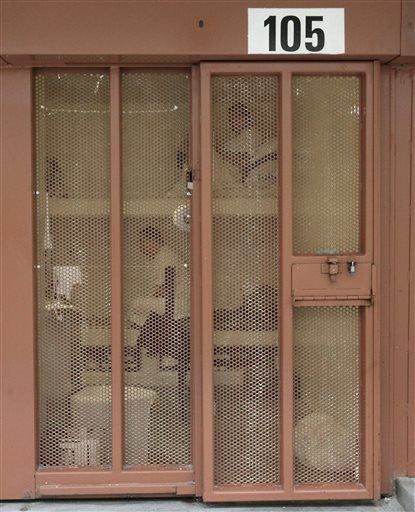
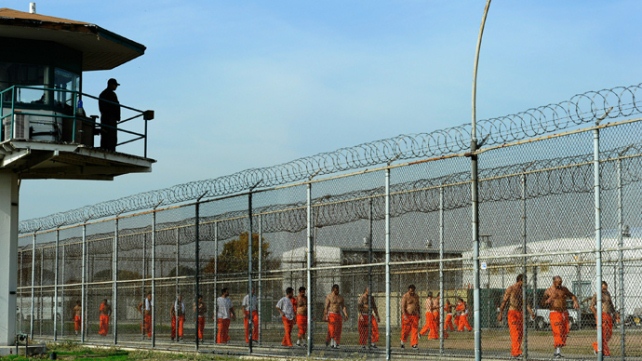
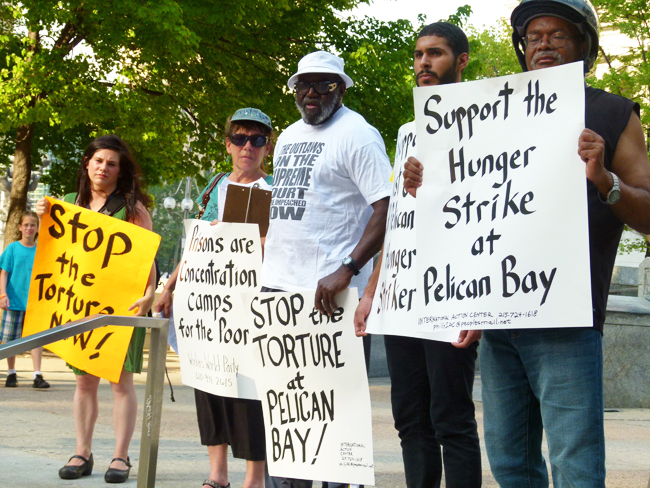
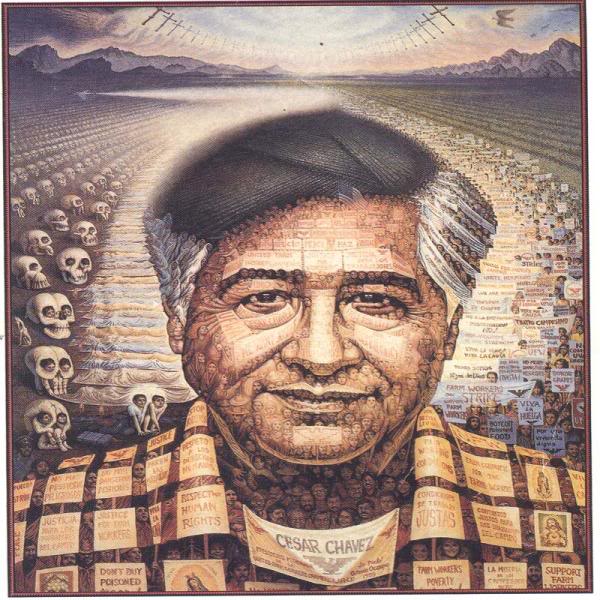




Two Black teens physically fight two white Detroit Police cops who threw unjustifiable punch. http://www.youtube.com/watch?v=DvUDOukhW_M
I have posted the video on Voice of Detroit, with an explanation that last year’s Michigan Supreme Court decision in the Moreno case upheld the common law right to resist illegal police conduct and arrest, which this clearly was.
Pingback: Calipatria prison hunger strikers resume eating, get more calls, cable – Los Angeles Times - The Cream of Internet! - MyNetLike.com